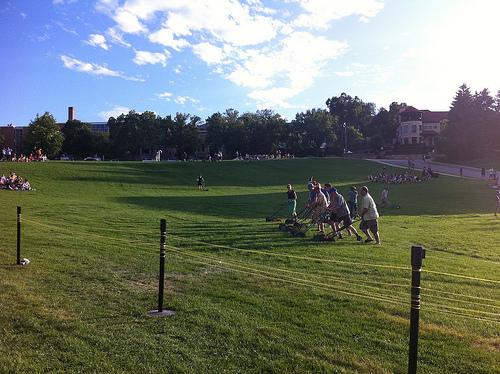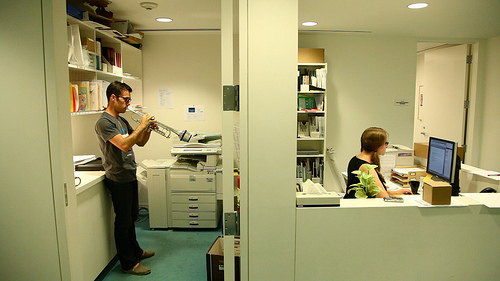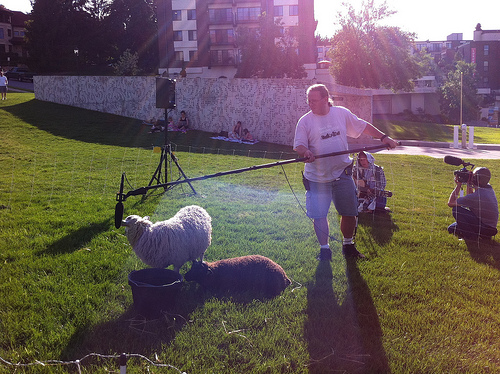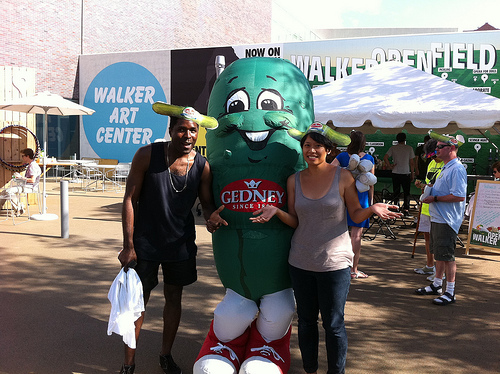Interview Between Sarah Schultz and Mark Allen
Discussion between Sarah Schultz and Mark Allen about the Open Field at the Walker Art Center (July 28th, 2011).
Sarah Schultz is the Director of Education and Community Programs at the Walker Art Center.
Sarah: Here we are!
Mark: Here we are!
Sarah: I thought it might ground the conversation if you could talk about your broad take on Open Field.
Mark: What I think works really well about Open Field is that it is a space to do projects that is not under a lot of editorial pressure from the institution. Often when I’ve worked in museums, you can have a theoretical conversation about the value of experimentation but you can still feel the institution’s almost psychic pain when projects go embarrassingly wrong—which itself is one of the most fruitful and exciting parts of an experimental practice, that things can go wrong. The Open Field is a complex enough public container that it allows for things to fizzle without people feeling necessarily embarrassed.
Often with projects in museums, there are a lot of clear signifiers – whether they’re architectural or economic or introduced with signage – that tell you what the important things are and what the unimportant things are. My experience of doing projects with the Walker – not just in the Open Field but in general – is a feeling of benevolent neglect in terms of the curatorial ambitions of the Museum. So, as an artist, it is a much easier way to work, and it allows you to feel more like it’s just a space or that it’s your space, not a space defined exclusively by the museum’s directive.
When thinking about how cultural institutions function in society, I often think in terms of metaphors of permeable membranes. After working here, I think about it like an airlock: there’s the outside world, which isn’t necessarily an art context, and there’s inside the museum, which is clearly an art context. The Open Field is this transitional space that the visitor passes through to go into the museum, so projects can propose different ways of looking at things in a very informal way that has a lot more flexible potential.

Sarah: Some of the criticism or the ambivalence about Open Field happens around that notion of the space that is an airlock. Some of the questions from that side are if that is the real experience of the museum, and does the space have the appropriate air of criticality that a museum experience should have?
Mark: The answer really depends on your philosophy of the purpose of the museum, and that’s a complicated question. There is a core traditional function that art museums do very well, which is to protect, preserve, and historicize objects, and to provide a focusing lens for the viewer to access those objects. The museum space is no more intrinsically critical than a telescope is; it’s just a way of focusing. What you choose to focus on, and how you choose to articulate the relationships between things is where the curatorial criticality emerges in the institution. And that’s not intrinsic to the fact the museum exists, it’s dependent on how the particular curatorial process works.
What I think is interesting about the Open Field is that it does something that I believe is important for the museum’s function, which is to construct a more discursive kind of space. The limitations of the museum purely as this focusing lens is that it a priori declares what is valuable to look at, so the audience is not part of a discursive space so much as in the position of an observer.
I think in a very broad sense that what is important about art in our culture is that it is a space for thinking about and proposing ideas that are not functionalized. It makes a space where we can look at an idea without saying, OK, but does it make money? Or saying, OK, but does it cure cancer? Or, OK, but does it save on gas mileage? We can look at ideas as potentially just interesting in themselves. I would like museums to more explicitly invite the public to be part of that process.

Sarah: Along those lines, Open Field is an experiment and there have been some questions about what occurs on the field that might be adapted for inside the museum. How important is it that the messy space, whether it’s an artist project or a space outside the museum, is physically bounded and contextualized? Does it become too chaotic if the whole museum is the messy space?
Mark: In Machine’s past projects for museums, they can sometimes feel more like a direct critique of the function of the museum because they suggest an alternative reality or another way of doing business in the space. When we did the one-day project at LACMA, even though it was not a sustainable way for a museum to operate, it allowed you to imagine the museum as a sort of carnivalesque performance space full of continual activity.
I’m currently trying to think about how to embrace projects that are exploratory and contingent while, at the same time, maintaining the museum’s traditional functions. How do you do both things without saying one is better than the other or one should replace the other? And how do you sustain that tension between the two? There’s a real value in sustaining that tension because it allows you to take what is often invisible about the particular mode of looking that museums facilitate and makes it visible. It’s not about one replacing the other so much as it is about emphasizing what is special about each.
It’s kind of like ice cream and hot fudge: I don’t want to have just a giant bowl of hot fudge, it’s a little bit gross; and just ice cream is a little bit boring; having the contrast makes both things seem better.
So I think embracing the experimental within the museum is so complicated in contemporary art museums because, traditionally, they present experiments that worked out really great. That doesn’t mean they present experiments at their institutions that are happening in real time and may be embarrassing for everybody involved. It’s the thing that just happened, not the thing that is happening at that moment.

Sarah: It’s really critical that you find a way to let the audience know that we’re all in the middle of an experiment together, to be sure that we’re being inclusive in this discursive space.
Mark: I think you gain so much leverage by making that extremely simple-minded. And this is what I said to you before we started. We do a lot of things which suck, which are bad, which are, by all accounts, not good.
Sarah: Right.
Mark: And you could say this to the audience, that a large percentage of the things we do will not be good—and it’s not because you didn’t get it, or you’re dumb, or you don’t understand contemporary art. But it gives you the opportunity to be there when something exciting happens. And actually, if you can move your embarrassment outside of yourself, it’s really pleasurable to be at those events which kind of fizzle, right?
Sarah: Right. But there’s a difference between doing that for 20, or 30, or 40 people, or two people in an environment that’s free, as opposed to a 350-seat auditorium where you just paid $35 for the ticket.
Mark: Yeah, that becomes more complicated. The question is, how does the contemporary art museum expand into being experimental space as well? This is how I’ve started to think about Machine Project. The storefront, in particular, is like the R&D lab, where the things get tried out. And then when we go to other museums, sometimes we enter a scenario like we entered with you guys at The Walker, where we could bring the R&D, actually, to a large institution and have it supported.
Sarah: And I think it’s interesting too to think about this notion of what is the recently successful, or what is replicable, and what was amazing just because it fell in that kind of liminal, temporal, experimental, you-had-to-be-there moment.
The idea of the folkloric is something that resonates with my understanding of how people experience Open Field and how ideas circulate and how community gets formed in our consciousness. I wonder if there’s something – and I hesitate to use the word “mythic” but I was wondering if you could talk about your idea of the folkloric – of people talking about a piece that happened even if they were not present.

Mark: I think there is something in particular about projects that are contingent and unreliable that connects to how events and stories happen in our lives. In life, it’s not that there’s an event and you are either there or not there when it happens, but there’s the possibility that it might not be good. You don’t necessarily know which party you go to will give you an epic story that you’re going to talk about for 10 years. I think that uncertainty generates a sense of possibility that doesn’t happen very much in museums, because the quality is known.
Work does not enter a museum until a bunch of people have decided it’s really good. But in Open Field, things enter without anyone knowing if they’ll be good or not and sometimes without anybody knowing they’re entering at all. So as an audience member, your presence becomes more important—not that you make the work, but that you might be witnessing a tiny historical moment. If it is already guaranteed to be important beforehand, the public doesn’t get to be an active part of that micro-history-making. So whether or not you attend the project, you can participate in perpetuating it as news or something significant.